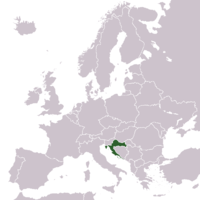Wikijunior Europe: Croatia

Croatia is a country in southern Europe. It shares borders with Slovenia, Hungary, Serbia, Bosnia Herzegovina and Montenegro. The capital city is Zagreb. Other big cities are Split, Rijeka and Dubrovnik. The currency of Croatia is the euro. On July 1, 2013, Croatia became the 28th member of the European Union.

Croatia's History
editThe name Croat dates back to 6th and 7th centuries, when the Croats came from the Carpathian Mountains to today's Croatia.
From the early 20th century Croatia was part of Yugoslavia. In 1991, Croatia proclaimed independence by holding the first democratic elections in the country. The complicated situation meant that it was forced to fight a brutal war took place that devastated many parts of Croatia and other parts of Yugoslavia.
Croatia was recognized as an independent country on January 15, 1992 by the European Union and the United Nations. The first country to recognize Croatia was Iceland on December 19, 1991.
Croatia's Geography
editCroatia is famous for its diverse geography. Although it is a small country, Croatia has thousands of kilometres of coastline and more than thousand islands. Inland the government has set aside large parts of the country as national parks and forests.
The largest island is Cres which is 405km². The highest mountain in Croatia is Dinara at 1,830 metres.
Croatia's People
editThe majority of people in Croatia are Croats but there are also large minorities of Serbs. In addition there are small minorities of Hungarians, Italians and Bosnians. The language of Croatia is Croatian which was previously known as Serbo-Croat. The majority of Croats are Catholic but there are also many Orthodox Christians and Muslims. Small numbers of Italian speakers live in Istria in the north-west of the country.
Croatia's Sights
editCroatia is one of the most popular holiday destinations in the world. It is famous for its thousands of kilometres of indented coast line and islands. It is home to many national parks, UNESCO World Heritage Sites and historical cities. The city of Dubrovnik in southern Croatia is considered to be one of the most beautiful cities in the world. Other places popular with tourists include the Istrian peninsula (and its cities of Pula and Rovinj), the capital Zagreb, Split and Zadar.
More than 12 million tourists visit Croatia every year. The country has seven UNESCO World Heritage Sites including: Plitvice Lakes National Park, an area full of lakes, caves and forests and the Old City of Dubrovnik, consistently rated as one of the most beautiful cities in the world. Before the wars in the 1990s ten million tourists visited the country every year. During the Yugoslavian wars tourists disappeared and the number of tourists didn't reach pre-war levels again until 2006. Now more tourists visit the country than ever before.
| Wikijunior Europe • Intro • EU • Geo • People • Language • Facts • Quiz | edit | ||